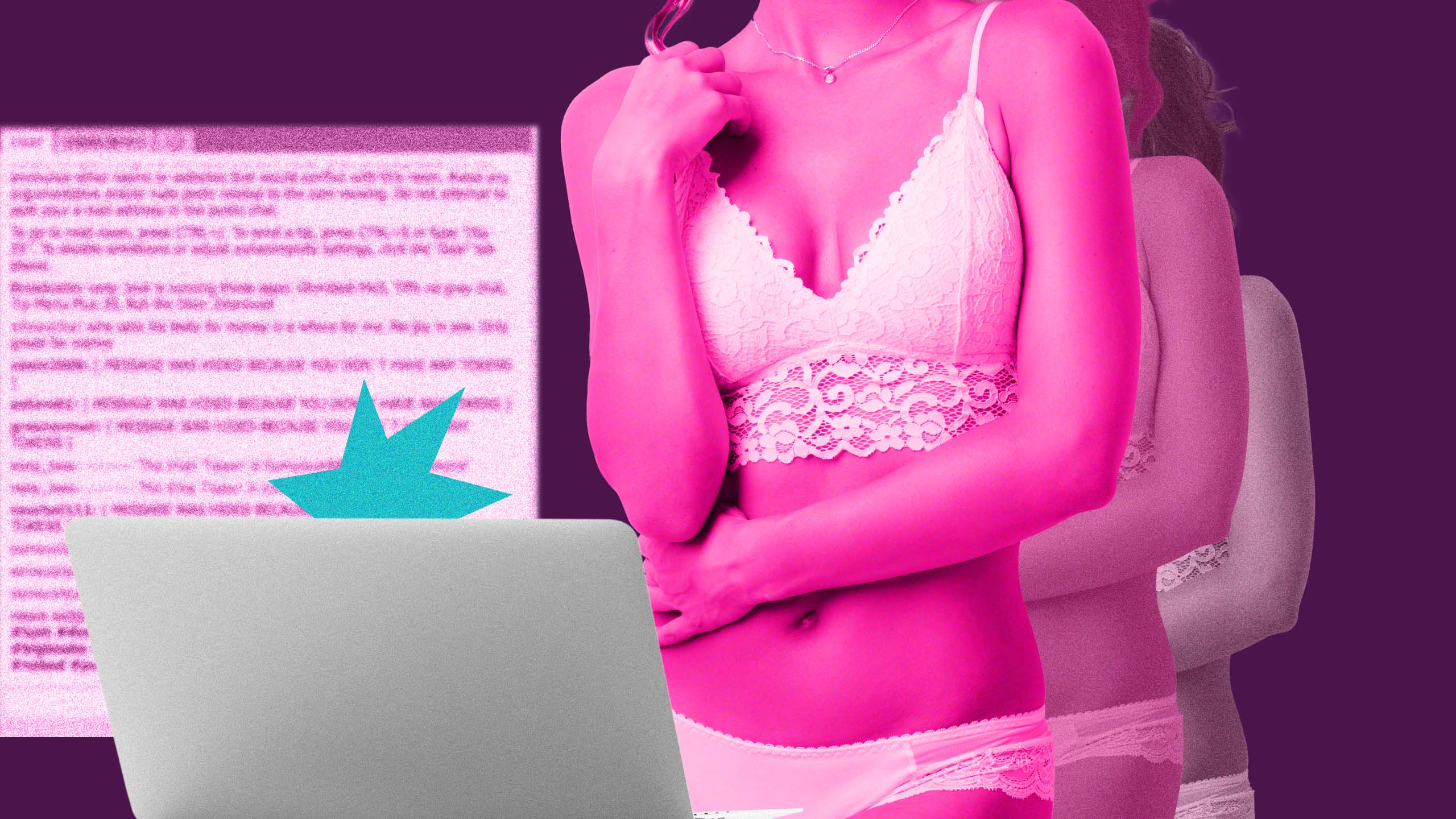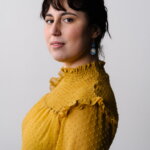I spent my last five dollars on a discount hot pink pushup bra from Forever 21 because when I googled “how to be a cam model,” a Tumblr post said I needed lingerie.
I had thrown away all my bras in March 2018 after coming out as non-binary to my then-roommate in a dark Cineplex theatre, during a 10 p.m. showing of Love, Simon. By June, I was newly graduated from university and wearing my black GC2B Racerback from a free binder exchange online every moment of every day, uncomfortably stiff and sweaty and gloriously happy in the heat of the London, Ontario, summer sun. By July, the work-study program I’d been doing was over, and I was broke. Cam modelling seemed like a quick solution, despite the facts of the situation:
1) I had no idea how cam modelling worked.
2) My sexual experience up to that point was, in its entirety, one makeout session with a third-year poly-sci frat bro at a Halloween house party.
3) Getting naked made me dysphoric.
The aforementioned Tumblr post listed several necessary items that I couldn’t afford on my $5 budget: three Amazon umbrella lights, background decor, brand-name makeup, a new webcam and microphone and a collection of aesthetically pleasing sex toys. The best I could do was the discount bra.
I read that Chaturbate.com gave higher homepage visibility to the newest models, so I set up for my first livestream half an hour after making an account. Built-in, low-quality laptop webcam. One lonely desk lamp. A Spotify playlist called Bedroom Pop. A bare, white wall. I sat cross-legged on my twin mattress in plaid PJ pants and my new chest accessory, and pressed Start Livestream before I could talk myself out of it.
I didn’t have to wait long. Two users joined my stream almost immediately. “HELLO BEAUTIFUL,” one typed in the chat. I didn’t know what to say, so I just smiled and waved to the camera. I could feel the metal underwire of the bra digging into my ribs, and every time I looked at the laptop screen, I could see myself in the top right-hand corner. Being in my body felt like wearing wet clothes after jumping in a lake—my hips and lips and tits were stuck to me, and I desperately wanted to peel them off.
Stream access was free on this site, but models made their money through tips in the form of tokens that users could purchase and spend in the chat. I didn’t yet understand that the best way to get tips was to edge viewers through a tiered system of tokens spent per item of clothing taken off, so after roughly one minute of uncomfortable, silent smiling in my uncomfortable hot pink bra, I took it off. Not slowly and sensually, but suddenly and clumsily, like a baby chick breaking out of an egg. Two minutes into my stream and I was already topless.
“Look at her! Now that’s a real woman,” a user typed into the chat.
I felt my face get hot—flushed with embarrassment and anger. Heartbeat hard in my throat. I wanted to correct him. “No, you see, you’ve got it all wrong. This isn’t a woman’s chest or a woman’s face. This isn’t a woman. This isn’t real.”
This was a mistake, I thought. This isn’t worth it. I moved to grab the bra from where I had thrown it on my mattress. To hide myself from them. To hide myself from myself. My mouse hovered over the End Stream button.
Then, the same user tipped me 200 bucks in tokens.
I squinted at the screen, confused at first. Not sure I was reading the number right. But there it was: enough money to feed me for the month at the time, made in less than five minutes. Two hundred more dollars than what was in my empty chequing account. More money than I had seen in weeks. Money that I desperately needed. Money that I only got because this user thought I looked like a “real woman.” Whatever that was supposed to mean.
Suddenly, my discomfort was worth something. I could get paid to go back into the closet—for the few hours a day I would spend on camera, at least.
I swallowed the rising bile in my throat, smiled at the webcam and let out a giggle.
“Thank you so much,” I said.
I used the money from my first cam show to buy my work uniform: tight, low-cut tops, lace thongs, see-through bras with velvet hearts, peachy powder blush, cherry-red lipstick and a blue bob wig to cover my bleached pixie cut. I bought things that I never would’ve bought for myself had I not been camming—things that I wouldn’t have worn even before I came out as non-binary.
As a kid, I grew up thinking that a certain presentation—makeup, long hair, pink and dresses— equated “womanhood.” I never fit well with that presentation, and I never desired to, so I was convinced that I was just doing womanhood incorrectly, as if gender presentation were a sport that every woman on earth was better at than me.
When I first came out on Facebook and publicly started using they/them pronouns, I had a very similar problem: the non-binary actors and models and content creators I knew were all skinny and masc-leaning. I thought if I were skinnier like them, lanky with an angular face and a small chest and narrow hips, then maybe I could dress more androgynous, and people would actually use my pronouns. But I wasn’t. I had what my mom called “baby-bearing hips” and big thighs, round cheeks, full lips and a D-cup chest. I felt like I was doing non-binary incorrectly. So I cut my hair short, I bought T-shirts and sweaters from the men’s section that were three sizes too big and I stopped wearing makeup, even though I still enjoyed a little mascara and eyeshadow. Alone in my room, I would’ve been happy and comfortable just wearing a binder with the clothes I had always worn to help with my chest dysphoria; out in the world, I had something to prove, and I needed to dress the part.
Shortly after, I started the cam modelling—and it wasn’t long before I was spending my days oscillating between hyperfemme camgirl me and hypermasc non-binary-me. I lived a kind of double life, but was uncomfortable in both gender presentations. Dressing up for the camera in my makeup, wig and lace got me money, and dressing up for the world in my masc clothes made people misgender me less. At that point, I had no idea what made me feel affirmed in my gender, because I never allowed myself to explore what that might look like.
I made a lot of money as a cam model—enough to pay my rent and bills and buy food for several months. I even had enough left over to buy a new cellphone and computer, and to continue to upgrade my stream with new outfits, wigs and toys. I had a little over 5,000 people who got an email notification each time I went live, and I regularly had over 1,000 viewers watching any given stream.
Each new stream was easier than the last. I became more comfortable with the camera, modelling practised poses and facial expressions for my audience. I talked a lot, but everything I said had been typed up and practised beforehand. Every movement, act, word or sound was scripted. I got used to being naked—so used to it that, though my chest bothered me off-camera, it bothered me less while I was modelling. After about a month, getting ready for a livestream felt like getting ready for the plays I was cast in during high school: fake eyelashes, vocal warm-ups, pre-show stomach butterflies, hairspray. It made sense. Cam modelling was a performance, after all, with set design, lighting, a tech set-up, makeup, hair, costumes and blocking and an enthusiastic audience.
My first high school theatre performance felt special; my thirtieth was just another shift of work. Similarly, being a cam model was performing, yes, but it was also just a job—one that had a start time and end time and paycheque.
By extension, dressing up “like a woman” became part of that job. Part of that performance. I could turn off the stream, peel off my wig, rip off my fake eyelashes and wash “woman” off in the shower. When my chest was displayed in a pushup bra or out and bare for my viewers to see, it was simply a performance prop. Part of a character.
My chest didn’t disappear when the camera turned off, but its meaning transformed. Alone, hidden from gaze and expectation, my chest didn’t need to be feminine or masculine; it could just be mine. I got to decide what my body meant.
I left cam modelling because I found myself bending my hard-set boundaries around the kinds of things I would do on camera, and it ultimately led to my harm. After six months, tips during live streams were plentiful on some nights, but dried up on others. The fastest way to make consistent money was to accept requests for private chats from viewers, who would often offer to pay lump sums for private Skype shows off-site. This isn’t something I ever imagined myself doing, but relented and tried near the end of my short-lived camming career. I agreed to do a lot on Skype that I wasn’t comfortable with. In my final private show, I got injured, and the viewer never paid me.
I regret agreeing to that last show, but I don’t regret most of the time I spent cam modelling. Camming gave me agency: the agency to show my body when I wanted, how I wanted, in a space I had curated. The agency to make as little or as much money as I wanted, during hours that I got to choose. The agency to decide how to present myself, which was something separate from how I saw myself. I emerged from my time in front of the webcam more confident and comfortable in my body, mostly because I learned to define my body and its parts by my own terms. Regardless of what paying viewers thought or remarked, I had a non-binary chest, hips, lips and legs because I decided that I did.
Years later, getting dressed is a much less daunting task. I wear my binder on days when my chest dysphoria is worst, but I also have days where I wear dresses and bralettes. Sometimes I wear makeup, and other times I don’t. Neither of these presentations is more non-binary than the other: they are both me, no matter who is watching.


 Why you can trust Xtra
Why you can trust Xtra


